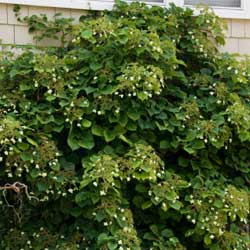For some reason, climbing hydrangea (Hydrangea anomala spp. petiolaris) doesn’t get the attention it deserves. Perhaps you didn’t know there was such a thing as a “climbing hydrangea.” Let’s remedy that.
It is hard to forget the sight of a mature, blooming climbing hydrangea. It can grow to 70′ along walls or fences without staking as it clings and twines with aerial rootlets. It will also cover a large area as an unusual and striking groundcover.
Wondering why you should plant a climbing hydrangea? In addition to its beauty, its vigorous growth quickly shades an arbor or provides privacy on a back wall. Growing on the side of a house, it cools in the summer. Because it’s deciduous, it allows sun warmth in the winter while exhibiting beautiful textured, cinnamon colored, exfoliating bark. Planted in the garden, the dark green leaves create a nice background for other flowers and often turn a golden yellow in the fall.
Climbing hydrangea takes patience to establish. Although quick growing once it has settled in, it can take up to seven years for this plant to bloom. But, it is well worth the wait. The fragrant white flowers appear on 4-10″ wide flattened sprays from early to mid summer and often hang on until early fall. The flowers are lovely when dried and use in wreath making.
Plant your hydrangea early in the season to allow root development before the temperatures go up along with the watering requirements. Slower growing in the first few years, it makes up for it later, sometimes growing 2′ per year. It flowers best in full sun but appreciates protection from hot burning sun. It isn’t fussy about soil, but prefers moist well-drained locations. Fertilize with a blossom booster in late winter and follow with a general-purpose fertilizer after blooming in late summer. Prune minimally during the first few years by removing dead, dying, diseased or wayward branches. Later, preform corrective pruning annually and control size.


